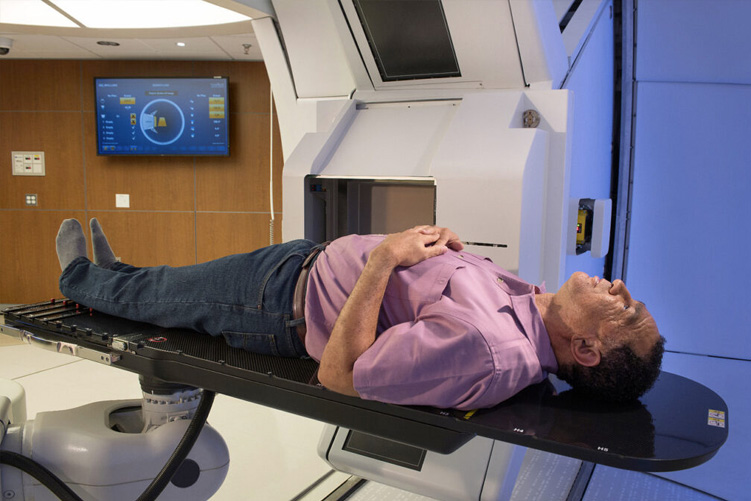Proton beam therapy represents a cutting-edge and continuously evolving approach to radiation therapy, offering real potential in alleviating the common side effects linked with conventional prostate cancer treatments.
What distinguishes proton beam therapy is its capability to precisely target cancerous cells with radiation while simultaneously sparing neighbouring healthy tissues. This precision is achieved by regulating the depth at which radiation is administered, thereby significantly mitigating the likelihood of harm to nearby organs.
Given the prostate gland’s integral role in the male reproductive system—responsible for seminal production—and its proximity to the bladder and rectum, traditional treatments like surgery and standard photon radiation therapy, while aimed at eradicating cancer cells, can inadvertently impact the surrounding healthy tissues. This can lead to an impact of treatment on adjacent organs that play pivotal roles in regular bodily functions.
Consequently, these interventions may result in distressing side effects such as urinary incontinence, erectile dysfunction, and bowel complications. Although these side effects are typically temporary, they can sometimes influence your overall quality of life during and after the treatment period.
Making an informed decision is crucial for any medical treatment, but it holds particular significance in prostate cancer care due to the intricate balance between eradicating cancer cells and preserving your overall well-being.
While proton beam therapy stands out as an effective treatment for minimising side effects, it is important to acknowledge that its availability has not yet become widespread. As a result, it often doesn’t find its way onto the usual lists of prostate cancer treatment options. This limited accessibility can sometimes obscure the potential benefits it offers, making it all the more important to explore and consider as you weigh-up your choices.
Why is proton beam therapy used to treat prostate cancer?
In clinical studies, proton beam therapy has been shown to be as effective as other treatments, such as surgery or standard photon radiotherapy, in treating prostate cancer.
It is a more precise and targeted treatment than some traditional treatments, and the benefits of this are twofold; it can effectively destroy cancer cells by delivering a high dose of radiation to the tumour while minimising damage to the surrounding healthy tissue. This can lead to better patient outcomes, such as fewer side effects.
How does proton therapy target cancer cells?
In high levels, radiation has the potential to damage DNA and cause harm to tumour cells. It is this process that has been harnessed to effectively damage cancer cells so that they can’t divide and reproduce, which means that they will die as a result.
Conventional radiotherapy treatment relies on high doses of photons. While they effectively harm cancer cells through DNA damage, photons inherently move through and exit the body beyond the site of treatment. Medical professionals and physicists have skilfully minimised the risk of damage from the ‘exit dose’ of photons by shaping the photon dose closely to the tumour, and trying to reduce the dose to normal tissues. For prostate cancer, avoiding this exit dose altogether can be a preferable approach.
Protons are positively charged particles that can be precisely controlled to deposit their energy in a specific location. When proton particles enter the body, they deposit their energy at the point that the radiation oncologist has planned, called the Bragg Peak.
Using techniques like pencil beam proton therapy, radiation physicists can conform the proton beam closely to the tumour. The ability to precisely plan where the radiation stops allows doctors to target the tumour with a high dose of radiation to destroy tumour cells while minimising damage to adjacent tissue or organs, such as pelvic lymph nodes, bladder and colon.

What are the benefits of proton beam therapy for prostate cancer?
Longer-term side effects of prostate cancer treatments can include urinary incontinence and erectile dysfunction, and it is preferable if these can be avoided.
Because proton beams deposit their energy so precisely and damage less surrounding healthy tissue, patients can be effectively treated for prostate cancer but tend to have fewer side effects than those treated with more readily available conventional treatments.
Reduced radiation exposure
One of the main advantages of treatment such as pencil beam proton therapy is that it can reduce exposure to surrounding healthy tissue. This is because protons deposit their energy without an exit dose. Reduced radiation exposure with proton beam therapy can minimise patient side effects.
Pencil beam proton therapy is used to treat a variety of cancers, including prostate cancer, brain tumours, and lung cancer. It is a good option for patients worried about the side effects of conventional radiation therapy, so it is worth considering proton beam therapy if side effects concern you.
Minimally invasive
Proton beam therapy is a minimally invasive treatment, which means it does not require any incisions or surgery. Patients who undergo proton beam therapy lie on a treatment table while the proton beams are delivered from outside of the body.
There is also no pain associated with the treatment, and patients can recover quickly from the effects of treatment.
Quality of life
When considering what treatment you should have for prostate cancer, it can be tempting, and understandable, to only think about getting rid of the cancer and not pay too much attention to how your life might be afterwards.
However, depending on the stage of cancer you have, there is a good chance that your treatment will be successful. It is important not to lose sight of this and to consider your quality of life both during and after treatment. You will want to make the most of it.
Does proton beam treatment cause any side effects?
Proton therapy is a radiation treatment for prostate cancer that uses protons to kill cancer cells. Patients should not experience pain or discomfort throughout their treatment sessions. As with any radiation treatment, there is a possibility of encountering side effects during or after treatment, but they are typically minor, and the treatment is generally well-tolerated.
Possible side effects might include fatigue, bladder irritation (cystitis), discomfort and pain in bowel opening (proctitis), skin reactions and hair loss in the region directly exposed to the proton beam along with fatigue. Your oncologist will thoroughly explain the specific side effects that you might encounter based on your individualised treatment plan.
How do I know if proton therapy is right for me?
If you have been diagnosed with prostate cancer, talk to your doctor about your treatment options, including proton beam therapy. Your doctor can help you decide which treatment is right for you based on your circumstances and cancer stage and will be able to refer you to an oncologist who specialises in proton beam therapy. You can also talk to other men who have been treated with proton beam therapy to learn about their experience.
Proton beam therapy may be a good option for you if you require radiation therapy and are concerned about the side effects of more traditional prostate cancer treatments.
Here are some factors that your doctor may consider when deciding if proton therapy is suitable for you:
- The location of the tumour
- The size of the tumour
- Whether the cancer has spread
- Your age and overall health
- Your risk of side effects from other prostate cancer treatments
Proton International London is a private proton beam therapy centre located in central London. It is a joint venture between Proton International and University College London Hospitals NHS Foundation Trust.
Proton International London uses a state-of-the-art proton beam therapy system to treat a variety of cancers, including some paediatric cancers, prostate cancer, head and neck cancers, brain tumours, spinal tumours, and lung cancer. Proton beam therapy is a more precise and targeted treatment than traditional radiation therapy, which can lead to fewer side effects for patients.
Our proton beam therapy consultants are globally recognised and have received extensive specialist training to provide safe and accurate delivery of proton beam therapy for prostate cancer to patients. We are also home to some of the country’s leading cancer experts who are involved in cutting-edge research and clinical trials.
It can help to talk to one of our consultants to learn more about our prostate cancer proton beam therapy treatments. Contact us today. We would happily answer any questions and determine if proton beam therapy suits your prostate cancer care needs.

This article has been clinically reviewed by Proton International Medical Director and Consultant Clinical Oncologist, Dr Beatrice Seddon. Dr Seddon specialises in the use of radiotherapy (including proton beam therapy) and chemotherapy for the management of soft tissue and bone sarcomas.
Further reading:





